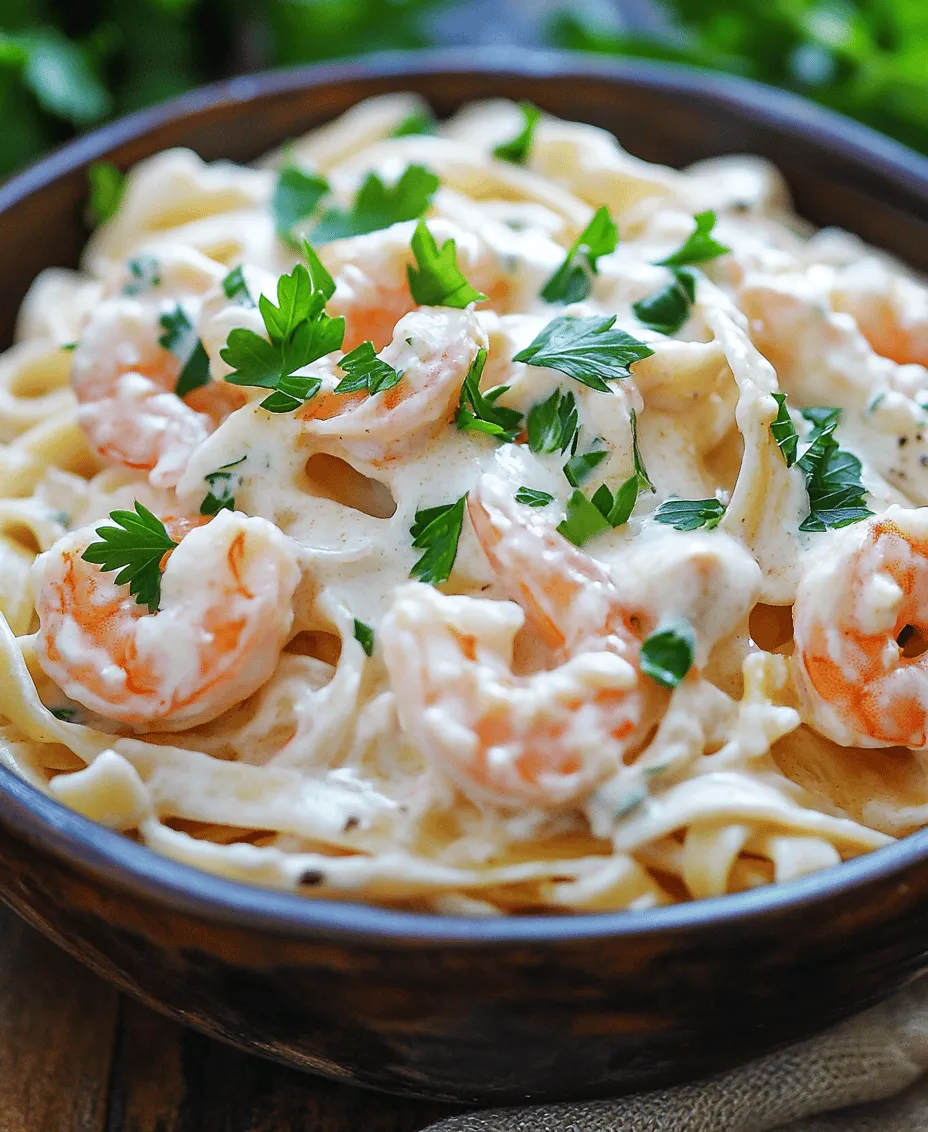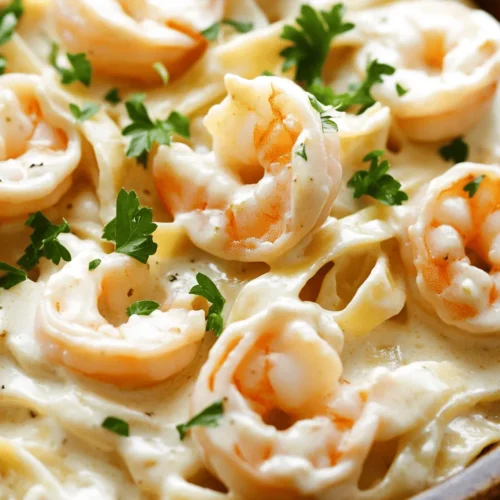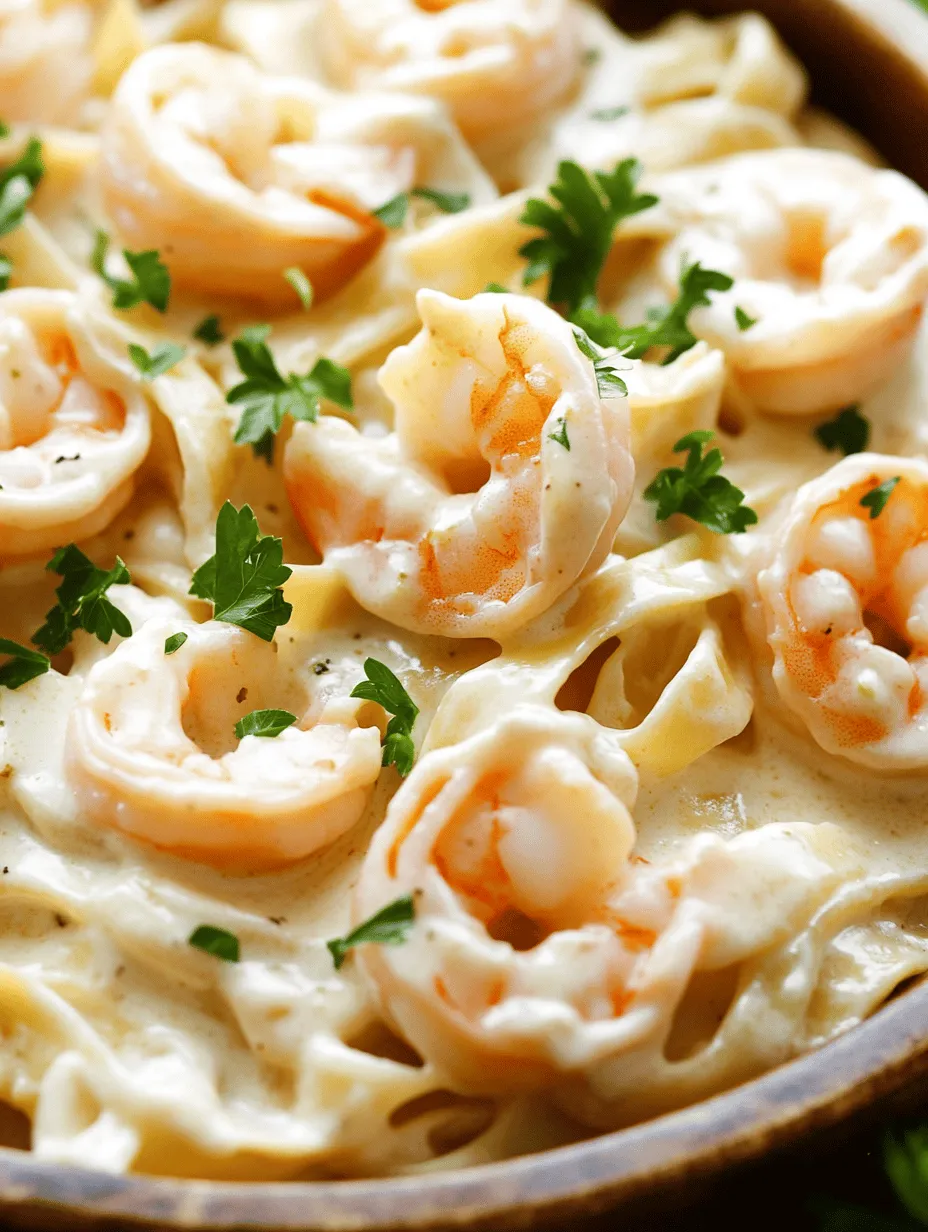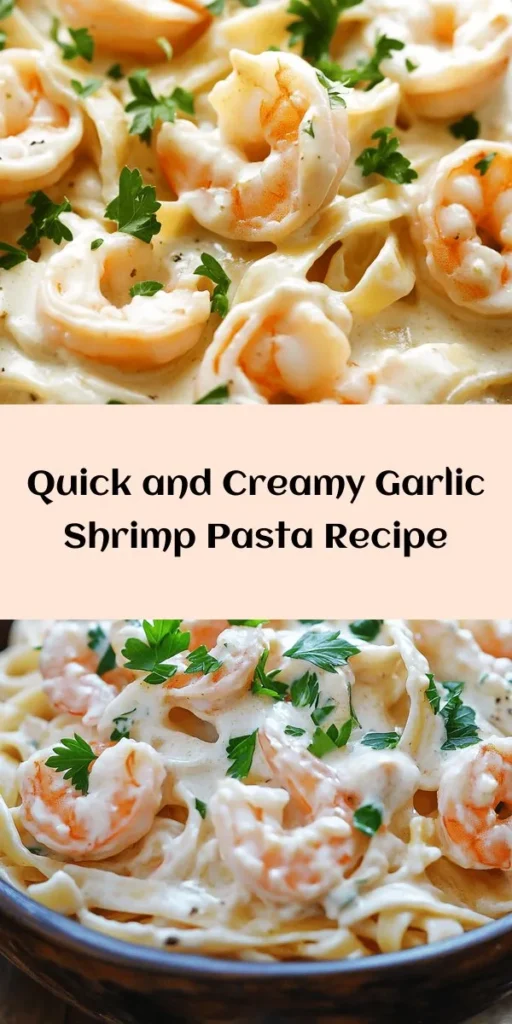Introduction
Creamy Garlic Shrimp Pasta is a dish that beautifully balances indulgence and ease, making it a go-to choice for both casual weeknight dinners and special occasions. This delicious meal combines succulent shrimp with a rich and creamy sauce, enveloping perfectly cooked pasta for a comforting and satisfying dining experience. The beauty of this dish lies not only in its mouthwatering flavor but also in its quick preparation. In less than 30 minutes, you can whip up this delightful meal, which has earned its place as a favorite among seafood lovers and pasta enthusiasts alike.
With its inviting aroma and luscious texture, Creamy Garlic Shrimp Pasta is more than just a meal—it’s a culinary experience that transports you to a cozy Italian trattoria. The combination of fresh shrimp, garlic, and cream creates a symphony of flavors that dance on your palate. Whether you’re cooking for family, friends, or just treating yourself, this dish promises to impress and satisfy even the most discerning taste buds.
As we delve into the recipe, we’ll explore the essential ingredients that make this dish shine, the different pasta options that complement the flavors, and the meticulous techniques that ensure your Creamy Garlic Shrimp Pasta turns out perfectly every time.
Understanding the Ingredients
Each ingredient in Creamy Garlic Shrimp Pasta plays a crucial role in building the dish’s flavor profile and texture. Let’s take a closer look at the key components that contribute to this delightful meal:
1. Shrimp: The star of this dish, shrimp brings a delicate sweetness and tender texture. When cooked correctly, shrimp can elevate the dish from delicious to divine.
2. Pasta: The base of the recipe, pasta acts as a canvas for the creamy sauce. The right pasta choice can enhance the overall mouthfeel and ability to hold onto the sauce.
3. Heavy Cream: This ingredient adds richness and creaminess. It helps to create a velvety sauce that coats the pasta and shrimp beautifully.
4. Garlic: Known for its aromatic qualities, garlic not only adds flavor but also brings health benefits, including anti-inflammatory properties.
5. Parmesan Cheese: A staple in Italian cuisine, Parmesan adds depth and umami, complementing the cream and garlic perfectly.
6. Butter and Olive Oil: These fats are essential for sautéing the garlic and shrimp, contributing to the overall flavor and richness of the sauce.
7. Seasonings: Salt, pepper, and optional red pepper flakes enhance the dish’s flavor and allow for customization to suit your taste preferences.
By understanding the role of each ingredient, you can appreciate how they come together to create a harmonious and delicious dish.
Pasta Choices for Creamy Garlic Shrimp Pasta
While the recipe can be adapted to various types of pasta, certain options work exceptionally well with Creamy Garlic Shrimp Pasta. Here are some popular choices:
– Fettuccine: This flat, thick pasta is ideal for creamy sauces, as its surface area allows for better sauce adherence. Fettuccine’s chewy texture pairs beautifully with the tenderness of shrimp, making it a classic choice for this dish.
– Spaghetti: A versatile option, spaghetti’s long, thin strands twirl nicely with the creamy sauce. It offers a lighter bite compared to fettuccine, making it a great alternative for those who prefer a slightly different texture.
– Linguine: Slightly wider than spaghetti, linguine offers a good balance between the two and is also excellent at holding sauces. Its flat shape holds the creaminess of the sauce while still allowing the shrimp to shine.
– Penne: For those who enjoy a more hearty pasta experience, penne can be a delightful choice. The tubular shape captures the sauce, ensuring each bite is filled with flavor.
When choosing your pasta, consider how the sauce will cling to it and the overall texture you prefer for your dish. Cooking the pasta al dente is key, as it will continue to cook slightly when mixed with the sauce, ensuring you achieve the perfect texture.
The Star of the Dish: Shrimp
Shrimp is not just an ingredient; it’s the heart of Creamy Garlic Shrimp Pasta. Selecting high-quality, fresh shrimp is paramount for achieving the best flavor and texture. Here’s what you need to know about shrimp:
Types of Shrimp
1. Wild-Caught Shrimp: Often considered superior in flavor, wild-caught shrimp are typically more sustainable and have a firmer texture. They can be more expensive, but many seafood lovers believe the taste is worth it.
2. Farmed Shrimp: While generally more affordable, farmed shrimp can vary in quality. It’s essential to source them from reputable suppliers to ensure the best taste and ethical farming practices.
3. Size Matters: Shrimp come in various sizes, typically categorized by count per pound. For this dish, medium to large shrimp (31/40 count) work well, as they provide a satisfying bite without overwhelming the pasta.
Selecting Fresh Shrimp
When purchasing shrimp, look for these indicators of freshness:
– Appearance: Fresh shrimp should have a translucent appearance and a slight sheen. Avoid any that look dull or have dark spots.
– Smell: Fresh shrimp should smell like the ocean, not fishy. A strong odor is a sign of spoilage.
– Shell Integrity: The shells should be intact and moist, not dry or slimy. If purchasing shelled shrimp, ensure they are firm and not mushy.
Once you have your shrimp, proper preparation is key. If using shell-on shrimp, you may want to peel and devein them before cooking. This step enhances the presentation and makes for easier eating.
The Creamy Sauce: A Culinary Delight
The creamy sauce is what truly makes Creamy Garlic Shrimp Pasta extraordinary. It combines simplicity with richness, creating a luxurious coating for the shrimp and pasta. Let’s break down the components of the sauce:
Heavy Cream
Heavy cream is the cornerstone of the sauce, adding a lush creaminess that is both satisfying and indulgent. Here are some tips for using heavy cream effectively:
– Consistency: When heated, heavy cream thickens beautifully, creating a velvety sauce that clings to the pasta. For a lighter sauce, you can substitute half-and-half or even a non-dairy alternative, although the texture may differ.
– Cooking Technique: To achieve the perfect consistency, add the cream gradually and allow it to simmer gently. Avoid boiling, as this can cause the cream to separate.
Parmesan Cheese
Parmesan cheese contributes a savory depth to the sauce. It’s essential to use freshly grated Parmesan for the best flavor and melting properties. Here’s how to incorporate it:
– Adding Cheese: Stir the cheese into the sauce after adding the cream, allowing it to melt and integrate fully. This step enhances the sauce’s richness and flavor.
– Substitutions: If you’re looking for a dairy-free option, nutritional yeast can provide a similar umami flavor, though it won’t replicate the creaminess.
Variations
For those looking to modify the sauce for different dietary needs, consider these options:
– Vegan Cream Sauce: Use coconut cream or cashew cream in place of heavy cream and nutritional yeast instead of cheese.
– Herb-Infused Sauce: Experiment with adding fresh herbs like basil, parsley, or thyme for an aromatic twist.
The key to a delightful creamy sauce lies in balancing flavors and achieving the desired consistency. The combination of cream and cheese creates a rich backdrop for the shrimp and pasta, making each bite a heavenly experience.
Flavor Enhancements: The Role of Garlic and Seasonings
Garlic is the unsung hero of Creamy Garlic Shrimp Pasta, infusing the dish with its unmistakable aroma and flavor. Not only does garlic add depth to the sauce, but it also boasts numerous health benefits, including boosting immunity and reducing inflammation.
Garlic Preparation
When using garlic in this recipe, consider the following:
– Fresh vs. Pre-minced: Fresh garlic is always preferable for maximum flavor. Pre-minced garlic can lack the same potency and freshness.
– Sautéing: Sauté garlic gently in butter and olive oil until fragrant, but avoid browning it. Burnt garlic can turn bitter and negatively affect the dish’s flavor.
Seasonings
In addition to garlic, seasoning is crucial for elevating the overall taste of the dish. Here are some key seasonings to consider:
– Salt and Pepper: Essential for balancing flavors, always season your sauce to taste. Start with a small amount and adjust as needed.
– Red Pepper Flakes: For those who enjoy a little heat, red pepper flakes can add a subtle kick. Sprinkle in a pinch and taste to find your preferred spice level.
– Fresh Herbs: Adding chopped parsley or basil just before serving can brighten the dish and enhance its visual appeal.
By thoughtfully incorporating these flavor enhancements, you can create a dish that is not only delicious but also tailored to your personal preferences. Each element works together to create a harmonious blend of flavors that will leave you and your guests craving more.
Step-by-Step Cooking Instructions
Now that we’ve explored the essential components of Creamy Garlic Shrimp Pasta, let’s dive into the cooking process. Here’s a detailed walkthrough to ensure your dish turns out perfectly every time:
Step 1: Prepare the Ingredients
Begin by gathering all your ingredients and preparing them for cooking:
– Peel and devein the shrimp (if necessary), then set aside.
– Chop the garlic finely, and grate the Parmesan cheese.
– Cook the pasta according to package instructions until al dente. Reserve some pasta water for later, then drain and set aside.
Step 2: Sauté the Shrimp
In a large skillet, heat a combination of butter and olive oil over medium heat. This mixture provides a rich flavor and prevents the butter from burning.
– Once the butter is melted and bubbling, add the shrimp in a single layer.
– Cook for about 2-3 minutes on one side until they turn pink and opaque, then flip to cook the other side for an additional 2 minutes.
Be careful not to overcook the shrimp, as they can become rubbery. Remove the shrimp from the skillet and set aside.
Step 3: Create the Creamy Sauce
In the same skillet, lower the heat slightly and add the minced garlic.
– Sauté for about 30 seconds until fragrant, being cautious not to let it brown.
– Pour in the heavy cream, stirring continuously to combine with the garlic and sautéed bits from the shrimp.
Allow the cream to simmer gently, thickening slightly.
Step 4: Incorporate the Cheese
Once the cream has thickened, stir in the grated Parmesan cheese.
– Mix well until the cheese has melted and the sauce is creamy.
– If the sauce is too thick, gradually add a splash of reserved pasta water to achieve your desired consistency.
Step 5: Combine Shrimp and Pasta
With the sauce ready, return the cooked shrimp to the skillet.
– Add the drained pasta, tossing everything together to coat the pasta and shrimp evenly in the creamy sauce.
– Taste and adjust the seasoning with salt, pepper, and red pepper flakes if desired.
Step 6: Serve and Garnish
Once everything is well combined and heated through, serve the Creamy Garlic Shrimp Pasta immediately.
– Garnish with freshly chopped parsley or basil for an added touch of freshness and color.
Following these steps will ensure that your Creamy Garlic Shrimp Pasta comes together seamlessly, resulting in a dish that is both visually appealing and deliciously satisfying. Enjoy the process, and savor the delightful meal you’ve created!
Stay tuned for the next part, where we’ll dive deeper into tips for perfecting the dish and addressing common questions about this beloved recipe.

Cooking the Pasta Perfectly
Cooking pasta to perfection is a crucial step that can elevate your Creamy Garlic Shrimp Pasta from good to great. The key is to cook your pasta al dente, which means it should be firm to the bite. This not only enhances the texture but also ensures that it holds up when combined with the creamy sauce.
To achieve this, start by bringing a large pot of salted water to a rolling boil. The general rule of thumb is to use about 1 tablespoon of salt for every 4 quarts of water. Once the water reaches a boil, add your pasta and give it a gentle stir to prevent sticking. Refer to the package instructions for cooking time, but typically, spaghetti or linguine takes around 8-10 minutes.
As the pasta cooks, keep an eye on the clock, tasting it a minute or two before the recommended cooking time ends. You want it to be tender but firm. When you find that perfect bite, immediately drain the pasta in a colander, but don’t forget to reserve about a cup of the starchy pasta water. This water is liquid gold; it can help adjust the consistency of your sauce later on.
Sautéing the Shrimp: Cooking Techniques
Sautéing shrimp is a quick and straightforward process, but it requires attention to detail to ensure they come out perfectly cooked. Begin by patting your shrimp dry with paper towels; this step is essential for achieving that lovely sear. Season the shrimp lightly with salt, pepper, and perhaps a pinch of paprika for added flavor.
In a large skillet, heat a couple of tablespoons of olive oil over medium-high heat. Once the oil is shimmering but not smoking, add the shrimp in a single layer, taking care not to overcrowd the pan. If your skillet isn’t large enough, sauté in batches to avoid steaming the shrimp.
Cook the shrimp for about 2-3 minutes on each side. They are done when they turn pink and opaque. Overcooking shrimp is a common mistake, so watch them closely; once they curl into a “C” shape, they are perfect. Once done, remove the shrimp from the skillet and set them aside. This will ensure they stay tender and juicy for the final dish.
Creating the Cream Sauce: Tips for Success
Now, let’s dive into creating a luscious cream sauce that will coat your pasta beautifully. Begin by using the same skillet where you sautéed the shrimp; this will allow you to capture all the flavorful bits left behind. Lower the heat to medium and add a tablespoon of butter. Once melted, add minced garlic (about 4-5 cloves) and sauté until fragrant, which should take about 30 seconds to a minute.
Next, pour in about 1 cup of heavy cream, stirring continuously. To achieve a creamy consistency, allow the mixture to simmer gently, reducing the heat if necessary. You can add a splash of white wine or chicken broth for depth of flavor. Season the sauce with salt, pepper, and a generous amount of grated Parmesan cheese, stirring until melted and well-blended.
If you find that your sauce is too thick, the reserved pasta water comes into play here. Gradually add small amounts of the starchy water until you reach your desired consistency. The starch helps the sauce cling to the pasta, ensuring every bite is flavorful.
Combining the Elements: Bringing It All Together
With the pasta cooked, shrimp sautéed, and cream sauce ready, it’s time to bring everything together. Start by adding the drained pasta directly into the skillet with the sauce. Toss the pasta gently to coat it evenly, adding the sautéed shrimp back into the mix. Ensure that every strand of pasta is coated in the creamy sauce, and feel free to add more reserved pasta water if necessary to maintain a nice, creamy consistency.
For an extra layer of flavor, finish off with fresh herbs such as chopped parsley or basil. These not only add a pop of color but also a fresh taste that balances the richness of the sauce.
Serving Suggestions and Presentation
Presentation plays a vital role in the overall dining experience, especially with a dish as visually appealing as Creamy Garlic Shrimp Pasta. When plating, use a pair of tongs to twirl the pasta into a neat mound in the center of each plate. Arrange the shrimp artfully on top, and don’t forget to drizzle some of the remaining sauce over the pasta for an enticing look.
For garnishing, sprinkle freshly chopped parsley or basil on top, and add a dusting of extra Parmesan cheese for a touch of elegance. Consider serving the pasta with a side of garlic bread or a simple green salad dressed with a light vinaigrette to complement the richness of the meal.
Beverage pairings can also enhance the dining experience. A chilled glass of white wine, such as Pinot Grigio or Sauvignon Blanc, pairs beautifully with the creamy flavors, offering a refreshing contrast.
Nutritional Information
Creamy Garlic Shrimp Pasta is not only delicious but can also provide a range of nutrients. A typical serving contains approximately 600-700 calories, depending on portion size and specific ingredients used. Here’s a breakdown of key nutritional components:
– Protein: Shrimp is an excellent source of lean protein, contributing to muscle repair and overall health.
– Carbohydrates: The pasta provides essential carbohydrates, offering energy for your day.
– Fats: Heavy cream and butter contribute saturated fats; however, the healthy fats in shrimp support heart health when consumed in moderation.
– Vitamins and Minerals: Garlic not only enhances flavor but also contains vitamins C and B6, while shrimp is rich in vitamin B12, iron, and selenium, essential for various body functions.
While this dish is indulgent, you can make it healthier by using whole wheat pasta, reducing the amount of cream, or substituting with low-fat alternatives. Additionally, adding vegetables like spinach, tomatoes, or bell peppers can increase fiber content and nutrients while adding vibrant colors to your plate.
Conclusion
In conclusion, Creamy Garlic Shrimp Pasta is a delightful dish that combines simplicity with elegance, making it perfect for both weeknight dinners and special occasions. By mastering the techniques of cooking pasta al dente, sautéing shrimp to perfection, and creating a rich, creamy sauce, you can elevate your culinary skills and impress anyone at your dining table.
This recipe not only showcases the flavors of garlic and shrimp but also allows you to get creative with presentations and pairings. Whether you’re enjoying it with family or hosting friends, this creamy garlic shrimp pasta is sure to bring joy and satisfaction. Embrace the joy of cooking, and let this dish be a staple in your repertoire, adding a touch of gourmet flair to your home dining experience.



